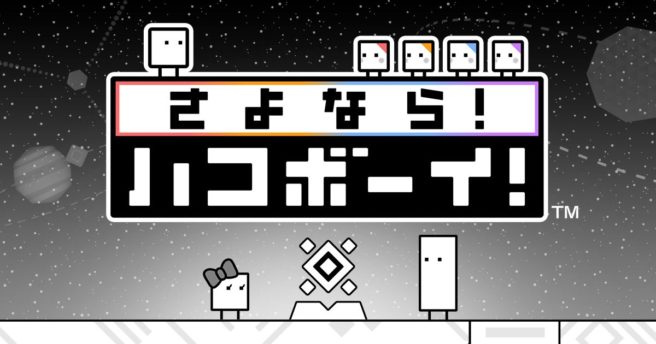BoxBoy! devs on the series’ origins, third game’s features, amiibo, and more plus Switch
Posted on February 12, 2017 by Brian(@NE_Brian) in 3DS, News
Nintendo released Goodbye! BoxBoy! in Japan last week. In turn, Famitsu caught up with a few of the game’s developers for a wrap-up interview. Director Yasuhiro Mukae, level designer Yutaka Watanabe, graphic designer Yusuke Ota, and programmer Takaaki Kawahara participated in the discussion.
The initial part of Famitsu’s interview touches on the start of the BoxBoy! series. Originally, the first game came about from a planning document Mukae created as part of a competition within HAL. He ended up as the series director, and determined how the project would be and what content it would have.
Kawahara was in charge of the programming team, and led the way on gimmicks as well as terrain detection. Oota has played a role in the series overall and was the lead designer beginning with BoxBoxBoy! Watanabe is brand new here. For Goodbye! BoxBoy!, he was a lead level designer and balanced the stage difficulty.
BoxBoy! wasn’t always intended to be a series. Mukae moved on to another project following the first game’s completion, but the positive response from players led to a second game. HAL was also set on creating a trilogy while working on BoxBoxBoy!
New to Goodbye! BoxBoy! are special powers and planets. Talking about the new features, Mukae points out how BoxBoxBoy! made use of two boxes. It allowed for a wider range of gameplay, though also increased difficulty. HAL wanted the third game in the franchise to use just one box similar to the original title, prompting the need for new features.
The new powers did cause some issues, and programming them wasn’t an easy task. For instance, the Box Bomb lets players destroy terrain. Balancing the difficulty for the different powers also took a great deal of effort.
The team intentionally made it so the powers would be limited to certain stages rather than throughout the entire game. Powers were meant to spice up the gameplay here and there. Had they been available everywhere, it would overshadow the series’ core concept of using boxes to move past obstacles and progress.
Watanabe later talks about how BoxBoxBoy! was aimed at those who had completed the previous title. Because of that, it was pretty difficult and carried many challenges. Yet with Goodbye! BoxBoy!, the team aimed for crisp gameplay similar to the original and wanted to make something that newcomers could feel comfortable with as well. However, even though it may not take a ton of effort to finish the main story, the subsequent levels after that will pose quite the challenge.
At first glance, Goodbye! BoxBoy! may seem somewhat colorful. The game was designed that way since players travel to different planets, and the developers wanted to make each one unique. Various patterns were tried so as to not ruin the general black and white aesthetic that was brought to the table since the first entry.
BoxBits are later covered in Famitsu’s interview. Oota pointed out how they were initially as big as Qbby, but the team decided to make them smaller after realizing that the players have to protect them.
Goodbye! BoxBoy! actually has the most stages in the series at 190. BoxBoy! contained 173, but this title has even more and also introduces new gimmicks. Mukae therefore thinks those who played past entries will find fresh gameplay here.
Aside from more levels, Qbby also has a larger selection of costumes this time around. Returning costumes are present along with brand new ones. Kawahara said that the team actually redid things for this game so that it would be easier to create new costumes. This was starting to become an issue in the past due to the amount of costumes that were being added.
The interview also has some talk about the new Kirby amiibo costumes. Starting with the first BoxBoy!, HAL had ideas about making the protagonist in the image of Kirby. Since there was also a collaboration comic between BoxBoy! and Kirby, they felt Kirby would need to be the star if amiibo support was introduced.
In crating theses costumes, the developers paid close attention to the placement of eye positions and colors so that you could easily tell that they are related to Kirby. They were made while referencing old Kirby pixel art. King Dedede required special care since he sort of looks like a regular penguin without a hat.
The interview wouldn’t have been complete without a question about having BoxBoy! Switch. Mukae indicated that it’s something he’s thought about. For the first BoxBoy! design document, he was interested in including multiplayer, which could lend itself well to Switch. But for now, he has nothing really to say specifically about BoxBoy! on Switch.
Watanabe closed out the interview by going back to the topic of difficulty. Even those who aren’t really that interested in puzzle games are apparently playing the BoxBoy! series. However, it seems as though there is a split between players who think it’s easy and those who believe it’s too difficult. Goodbye! BoxBoy! was therefore developed so that the early sections could be cleared more easily for beginners. Also, a hint feature is here once again, though you shouldn’t assume that it makes the game easy. Watanabe hopes that veterans of the series will give the challenge stages a try and enjoy the difficulty there.
